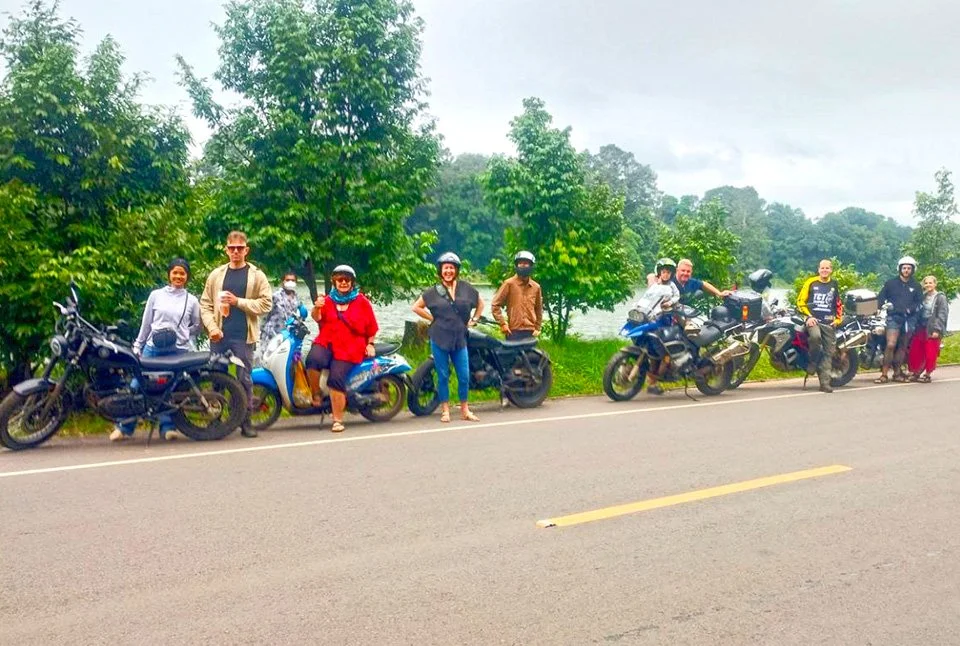Group Riding in Cambodia: Your Guide to Safe Adventures
Exploring Cambodia on two wheels is an unforgettable experience, but sharing that adventure with a group of friends multiplies the fun, transforming every scenic road and dusty trail into a cherished collective memory. Yet, group riding here, especially on Cambodia's beautifully unpredictable roads, demands more than just a sense of adventure. It requires discipline, clear communication, and mutual respect. This is precisely how we operate as a group of foreign riders on these public local roads (based on MOTOTOM experience).
We strive to find the perfect balance: adhering to our group riding rules while seamlessly adapting to the local traffic's unique quirks, as local riders don't follow, or even recognise, our kind of group riding protocols.
Navigating Cambodian Roads Together
(L=Leader;M=Middle;S=Sweep)
The Foundation: Your Safety Bubble
The core of group safety lies in its formation. On paved roads, the standard is a staggered riding formation. Imagine two parallel lines within your lane; the leader rides on the left track, the second rider on the right track, the third on the left, and so on. This left-right-left pattern gives each rider their own space, improving visibility and drastically cutting down reaction time in unpredictable traffic.
Just as important is spacing. Maintain a one-second diagonal gap to the rider directly ahead of you on the other track, and a two-second gap to the rider directly in front of you on the same track. This buffer is your best defence against sudden stops or the common hazard of animals crossing the road.
The Leaders of the Pack: Leader & Sweep Roles
Riders at Angkor Wat Park
Every group ride has two key roles: the Leader and the Sweep.
The Leader: Rides at the front, setting the pace for the entire group. They are the most experienced, navigating the route and scanning the road for potential hazards. No one should overtake the leader unless it's a pre-arranged and communicated manoeuvre.
The Sweep: The rear rider, often another experienced guide. Their job is critical: to support the group, assist with any breakdowns or issues, and ensure no one is ever left behind.
Riders in the middle have the simple but vital job of maintaining the group's rhythm and passing along hand signals.
Speaking Without a Sound: Clear Communication
Chris, Kamping Pouy
Cambodian roads are noisy. Shouting is useless and horns can be misinterpreted. Clear, universal hand signals are the only effective way to communicate. Key signals include:
Right Turn: Left arm bent 90° upwards.
Left Turn: Left arm fully extended horizontally.
Stop: Left arm extended downwards at a 45° angle.
Slow Down: Left arm out, palm down, with a gentle up-and-down motion.
When the leader signals, every rider behind them should mirror the signal to ensure the message gets all the way to the sweep at the back.
Navigating the Unexpected: Animals and Road Hazards
Sooner or later, you will encounter dogs, cattle, or chickens on the road. The golden rule is: to stay calm and not swerve suddenly. Brake smoothly if you have time and space, but keep your handlebars firm and your path straight. A sudden swerve is far more likely to cause a crash than a collision with a small animal. Control is always better than a panicked dodge. Always assume people, dogs, or other animals on the road will move unpredictably.
“Act as if people, dogs, and other animals will always move unpredictably.”
Before You Roll: Gear, Legality, and Maintenance
Pace & Personal Ability: The group pace is set by the leader and never exceeds the legal limit of 90 km/h on national highways. This pace will adjust based on traffic, weather, and road conditions. This is a group tour, not a race, and critically, never ride beyond your abilities. If you're struggling with the pace or encountering difficulties on challenging terrain like greasy mud or loose gravel, signal immediately to your fellow riders and the leader. Your safety and the group's cohesion depend on honest communication about your limits.
Legal & Safety Gear ( Personal Protective Equipment => PPE): A properly clipped helmet, gloves, and eye protection are essential for survival in an accident. Cambodian law requires a helmet, license, and mirrors. Stunts like wheelies are illegal and strictly forbidden.
Maintenance: While the tour leader manages the fleet, every rider must do a quick check of their bike each morning—tires, brakes, and lights. Report any issues immediately to ensure the safety of the entire group.
Breaks: Regular stops for rest, hydration, fuel, and photos are part of the journey. They prevent fatigue, especially on long, hot days or to avoid the heaviest short rains.
Summary: The Rider's Code
Ultimately, a safe and successful group ride depends on everyone following the same code.
DO be predictable, use your signals, and respect the group's rhythm.
DON'T overtake the leader or make reckless, sudden moves.
DO check your bike daily and stay focused on the road.
DON'T panic when animals cross your path.
DO remember that group safety is a shared responsibility built on discipline and respect for your fellow riders, and always ride within your limits.



